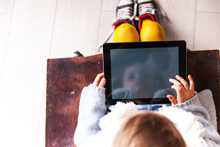These tips could help educators reach optimal iPad integration
 EdTechTeacher’s first iPad Summit was held in Boston in November 2012, and one of the first magazine articles that came out about our the event was: “The iPads in Education Conference That’s Not About iPads.” We loved the title. We will admit it; the title of the iPad Summit was a trick to get people who think they are interested in iPads to get really interested in great teaching and learning, which takes advantage of iPads.
EdTechTeacher’s first iPad Summit was held in Boston in November 2012, and one of the first magazine articles that came out about our the event was: “The iPads in Education Conference That’s Not About iPads.” We loved the title. We will admit it; the title of the iPad Summit was a trick to get people who think they are interested in iPads to get really interested in great teaching and learning, which takes advantage of iPads.
Three years ago, we started seeing schools and districts making major investments in iPads, and we started hearing those same schools ask for help to support teachers as they incorporated these new devices into their classrooms. Those early adopters have been joined by other schools at an incredibly rapid pace, and for these last three years we have studied the practices of the best early adopters and have examined their successes and challenges.
One conclusion we’ve drawn is that there are no must-have apps for every classroom. Every conversation about technology needs to start with the question: “What do you want your kids to be able to do when they leave your classroom, your grade, your building, or your district? What do you care most about? How might technology help you do what you care most about even better?”
(Next page: Five guiding iPad principles)
The heart of great classrooms has always been caring, passionate adults asking compelling questions that motivate students to deeply understand important skills and ideas. But we also believe that it is increasingly difficult to prepare young people for a digital world without letting them rehearse in mobile, online spaces. We believe that learning to work with new information is essential, and it is impossible to think about learning to work with diverse sources of information without asking students to learn how to efficiently navigate the internet. The end product of solving complex problems is often a performance—some of those performances are still written documents or mathematical computations, but increasingly, students need to be able to perform their understanding in print and in person, with media and online. Even those students who are excited about a working life in the trades need to be prepared to sell their services in an online marketplace, to constantly update their skills in online learning settings, and to participate in a civic sphere conducted in a networked world.
Putting iPads in the service of learning, in our view, means putting technology in the service of preparing students to solve unstructured problems and communicate persuasively and with deep understanding. That’s our vision of what great schools do.
As we approach the challenge of creating powerful learning environments with iPads, we use five bedrock principles to keep us grounded:
- Technology must be in the service of learning. Without a clear vision for learning, technology is the engine of a ship without a compass.
- Tablets are not computers. There are some things they do much better. There are some things they do much worse. Focus on exploiting what they do best.
- iPads are mobile, flexible media production devices–not repositories of apps. Teachers need a vision of powerful student-owned learning, and a few basic apps for media production and sharing.
- The iPad has a design bias towards consumption; great teaching has a design bias towards student production. To make the iPad support powerful learning, we work with educators on moving from consuming content to curation and creation.
- Technology initiatives will only work with broad support from community stakeholders: parents, teachers, students, and the community.
Your vision and principles may be different. They should be particular to the culture and the needs of the children that you serve in your community. Sometimes to help teachers think about these issues in a fun way, we’ll ask the question: “What does awesome look like?” If you are doing your best possible work, better than you have ever done before, what do the learners look like on the other end? When schools and educators answer this question they’re building a worthwhile iPad program.
Portions of this column are excerpted from: iPads in the Classroom: From Consumption and Curation to Creativity by Tom Daccord and Justin Reich.
Tom Daccord is the director of EdTechTeacher, a professional learning organization.
- Friday 5: Virtual field trips - April 26, 2024
- Google, MIT RAISE launch no-cost AI training course for teachers - April 26, 2024
- 4 ways to support work-based learning - April 23, 2024
